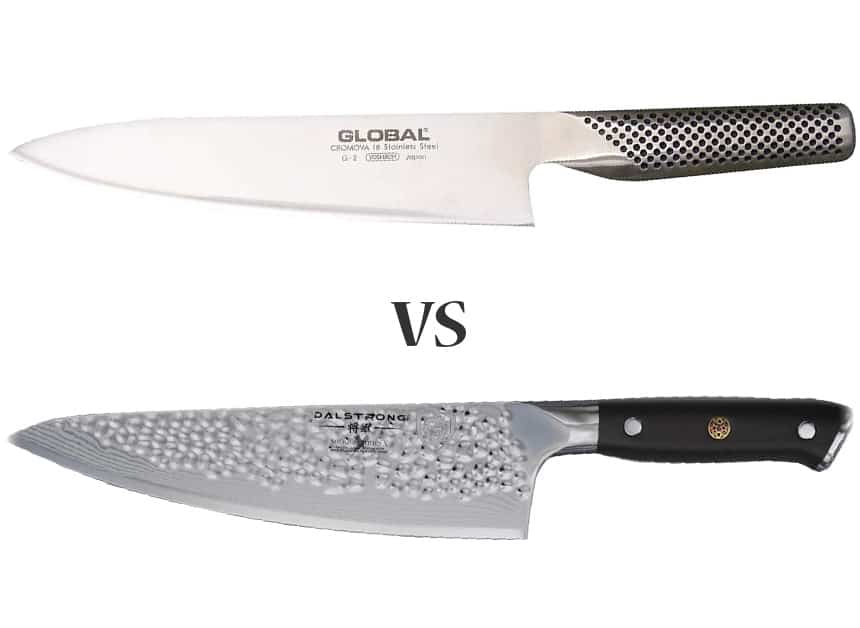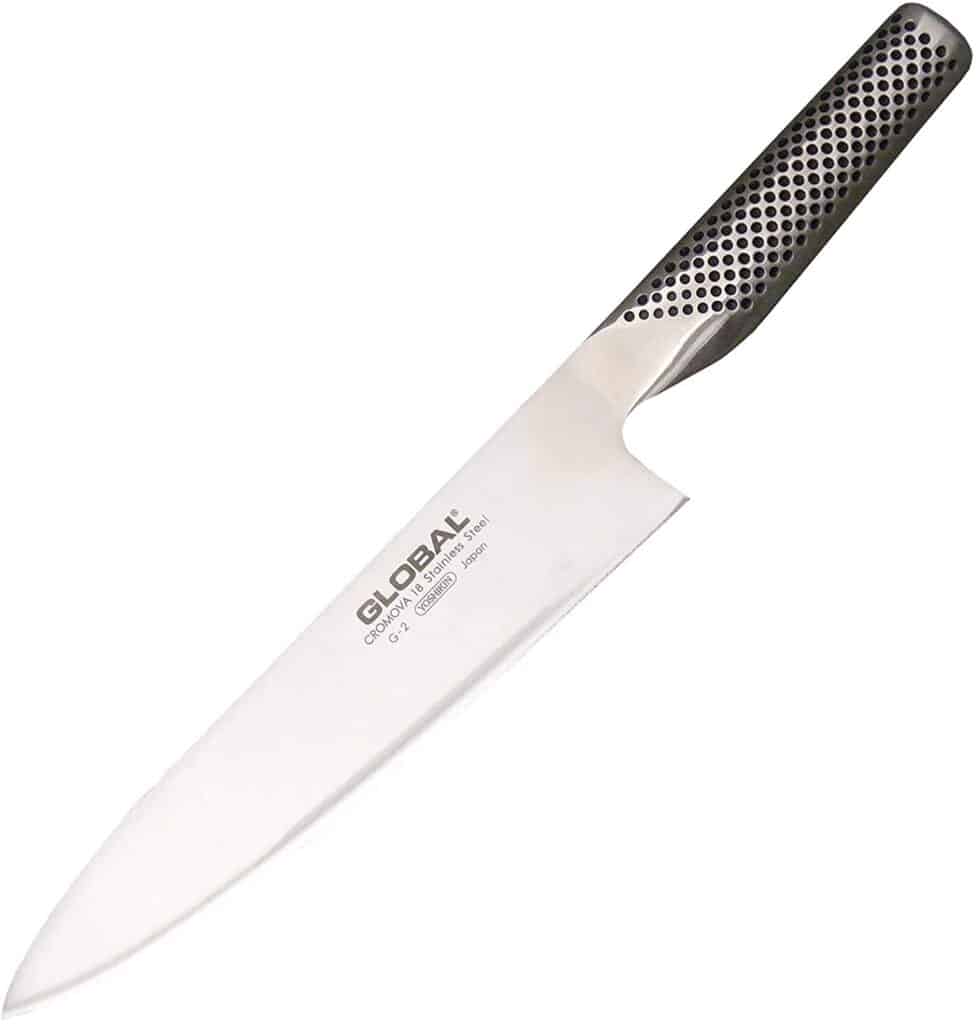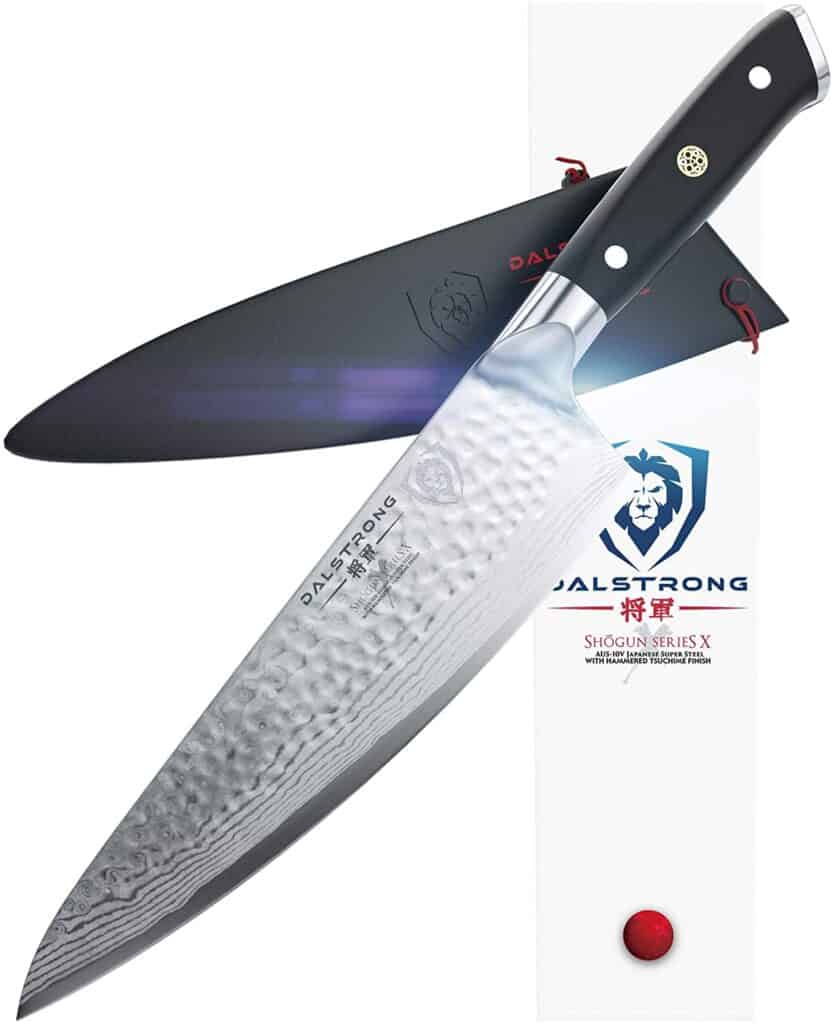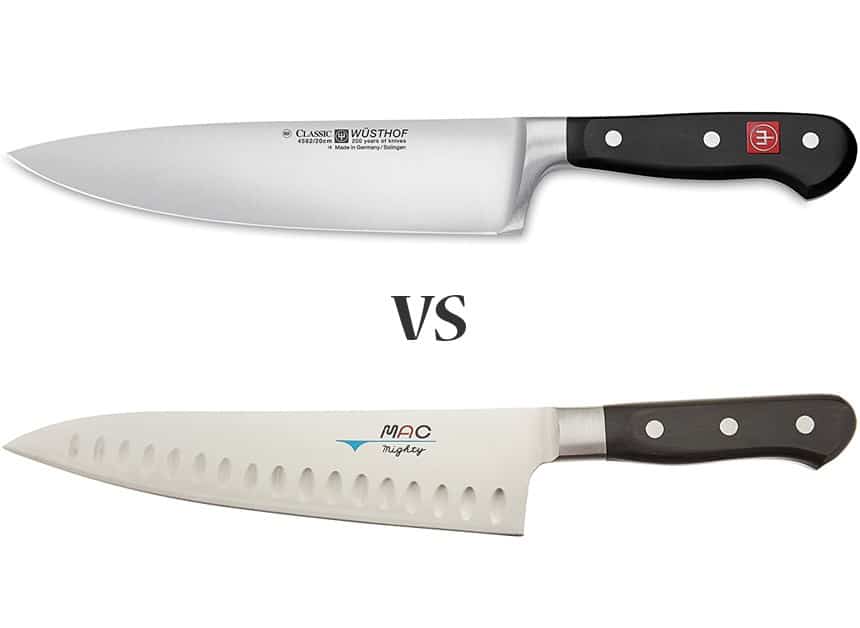
There have been a number of quality Chinese brands entering the market recently and competing directly with Japanese knives. One of the best Chinese knives around is Dalstrong.
As a result, people are often trying to choose between a good Chinese brand like Dalstrong and an authentically Japanese brand like Global.
In this article, I’m going to tell you the differences between these two brands. I’ll go in-depth into the details of each, talking about where they are made, what materials are used and the difference in price.
This should be all the information you need to select your perfect knife.
If you’re looking for an authentically Japanese knife that is lightweight and slim then Global knives are ideal. If you don’t care so much about heritage and want to get the most for your money in terms of quality materials then the Dalstrong is a great choice. Either way, both these brands offer terrific knives.
| My recommendation | Current price |
| Mac Professional 8-Inch | View on Amazon (opens new tab) |
| Dalstrong Shogun Series X Chef’s knife | View on Amazon (opens new tab) |
Global vs Dalstrong – Comparison Table
Here is my summary comparison table for each brand. This is mostly based on their main range of knives; the Global Classic (G Series) and the Dalstrong Shogun Series X.
For a more in-depth look at each category then check out the rest of the article below.
| Category | Global | Dalstrong |
| Country of Manufacture | Japan | China |
| Steel type | Chromova18 | AUS-10V (other ranges use AUS-8 and X50CrMoV15) |
| Rockwell hardness | HRC 56-58 | HRC 62 |
| Factory edge | 15 degrees (double bevel) | 12 degrees (double bevel) |
| Handle material | Steel | G10 (fiberglass laminate) |
| Price range | $150 – $170 (Classic/G Series) | $125 – $135 (Shogun Series X) |
| Main benefit | Very durable, lightweight and slim | Lower price and sharper |
| My recommendation | Global 8-Inch Classic (view on Amazon) | Shogun Series X (view on Amazon) |
Global vs Dalstrong – Where are they made
| Brand | Country of manufacture |
| Global | Japan |
| Dalstrong | China |
Global knives are manufactured in the city of Niigata, on the North-Western coast of Japan.
Niigata is where the Yoshikin metal manufacturing company has been based since 1954, so they have a good span of heritage making Japanese steels.
Both of these brands produce their knives in the homeland of their heritage, an added bonus for anyone looking for a genuine German or Japanese knife.
Dalstrong manufactures it’s knives in Yangjiang, China.
On the face of it, the fact that Dalstrong knives are manufactured in China might be a little off-putting.
Let’s be honest, when we see the words ‘Made in China’ we usually think that the quality isn’t going to be great, but with Dalstrong I think there are some large benefits from having production based there.
They still use quality materials, but as the manufacturing costs are kept low these savings are passed onto the customer.
Dalstrong provides a range of both Japanese and German-influenced knives, in this article though I’m mainly focusing on their most popular Japanese style, the Shogun Series X.
Global is the ‘real-deal’ in regard to being produced directly in Japan, whilst Dalstrong is definitely much less authentic.
Global vs Dalstrong – What steel do they use
Brands often use a variety of steel in their knives which changes between their ranges.
This is particularly true of Dalstrong. They use three different steels throughout their ranges as they have both German and Japanese influenced knives.
Their German series uses X50CrMoV15 and their Japanese series use both AUS-10V and AUS-8 depending on the range.
For a fair comparison, I’m going to focus on the most popular range for both Global and Dalstrong knives.
For Global that’s their Classic and for Dalstrong it’s their Shogun Series X range, which uses their best steel, AUS-10V.
| Brand | Steel type | Rockwell hardness |
| Global | Chromova18 | HRC 56 – 58 |
| Dalstrong Shogun Series X | AUS-10V | HRC 62 |
Global knives are made from their own specially formulated steel, Chromova18.
You’ll only find Chromova18 in Global knives and it’s a very unique steel. To understand why let’s look at some of its Chromium content.
The 18 in Chromova18, represents the steel’s Chromium content, which is 18%. That is a huge level of Chromium by any standard and it’s an amount you’ll rarely see in another knife.
That means that Global knives are especially resistant to rust, making them particularly durable. That’s really the theme of Global knives, they are Japanese knives but they have a focus on durability.
The Carbon content is quite high at 0.75 – 1.05%. Usually, that would lead to a very hard knife, which could hold a super-sharp Japanese style edge, but that’s not the case with Global.
The rather unique composition of Chromova18 actually results in a rather soft steel, with a Rockwell hardness between 56-58 HRC.
I don’t regard this as a bad thing though, it plays directly to the strengths that the brand wants from their knives; durability over sharpness.
A softer steel is less likely to chip and snap, and it’s easier to sharpen (although you would need to sharpen it more often).
Combine that with the 18% Chromium content and this is a knife that will last a very long time.
The Dalstrong Shogun Series X range uses Japanese steel AUS-10V. Other Dalstrong knives use X50CrMoV15 (for their German range) and AUS-8(another Japanese steel).
This is where we start to see the benefits of Dalstrong knives, the materials they use are very good quality, in this case, imported from Japan, but the Chinese manufacturing reduces the cost to the consumer.
AUS-10V is a Japanese steel with a great reputation. It’s a high carbon steel, with a Carbon content between 0.95% – 1.1%.
That means the steel is hard, allowing it to hold a sharper edge for longer.
The Chromium level is also high at 13% – 14.5%. It’s not as good as the Global but it’s still enough to make AUS-10V a quality stainless steel and therefore very rust-resistant.
The trade-off here is sharpness for durability.
The Global’s Chromova18 steel is more durable than AUS-10V, the high Carbon Dalstrong knife can hold a sharper edge but it will be more brittle and thus more prone to chipping along the edge.
That hardness is clearly shown in the Rockwell scale score, where the Dalstrong Shogun Series X knives have a much higher HRC than the Global, standing at 62 compared with 56-58.
Global vs Dalstrong – How sharp are they
Once again I’m going to focus on the most popular knives from each brand for this comparison.
You will experience a sharper edge using Dalstrong knives than Global knives due to the steel of Dalstrong knives being much harder.
| Brand | Factory edge | Rockwell hardness |
| Global | 15 degrees (double bevel with straighter edge) | HRC 56-58 |
| Dalstrong Shogun Series X | 12 degrees (double bevel) | HRC 62 |
Sharpness is vital when looking for a knife, but in this case, there’s a bit more to it than just looking at which knife has the smallest angle of its edge.
Usually, the smaller the angle the sharper the blade. However, there are other considerations that are particularly important when comparing these two knives.
Harder knives will hold a sharper edge for longer. Dalstrong uses much harder steel than Global.
Dalstrong uses a Japanese steel that focuses on hardness, in order to create a sharper edge.
Therefore the Dalstrong knife will actually hold its edge for much longer.
Global vs Dalstrong – What are the handles made from
The material used for handles is a vital and often overlooked feature of any knife.
A quality handle is often the sign of a quality overall knife. Handles need to be made from a durable material that can withstand all the heat and moisture fluctuations knives can experience in the kitchen.
| Brand | Handle material |
| Global | Chromova18 steel |
| Dalstrong Shogun Series X | G10 (fiberglass laminate) |
Global knives use their own steel, Chromova18 to create the handle, and form the whole knife out of a seemingly single piece of steel.
Technically the knife isn’t made from one piece of steel. The blade is made in one piece. The handle is made from a further two pieces, the handle is hollow and filled with sand in order to offer the perfect counterbalance weight to the blade.
All the pieces are then welded together to form a seamless knife, with the blade and handle becoming one.
It’s a fantastic design and results in the most durable handle you’ll find in any knife, it’s basically impossible to damage this handle unless you were pretty determined to.
As the stainless steel on its own would be difficult to grip, Global handles are always dimpled to provide extra friction. It’s a technique that works well and for home use, providing the cook with plenty of control over the knife.
Global handles are near indestructible and contribute drastically to the lightweight design of Global knives due to the hollowed handle.
Dalstrong uses a fiberglass laminate called G10 for their Executive Plus knife handles. Not all Dalstrong knives use G10 but all Dalstrong ranges do use good quality materials for their handles, such as Pakkawood.
G10 is a fiberglass laminate, making it a fantastic material for knife handles.
It has the perfect combination of being extremely lightweight and very tough. It will be able to withstand any of the standard pressure of a kitchen.
Dalstrong use a variety of materials for their handles, not just G10.
But they always use quality materials, such as the Pakkawood used for their Phantom Series, a quality wood/resin material commonly used as a material by traditional Japanese knife manufacturers.
Both the G10 and continuous steel are fantastic handle options, you won’t be able to damage a Global handle in normal use, and it’ll be pretty hard to damage a Dalstrong handle too.
But for pure indestructibility, Global wins.
Global vs Dalstrong – How much do they cost
Both these brands have wide ranges of knives all at differing price ranges.
To allow for a fairer comparison I’ve categorized three of their major ranges that represent their highest and lowest cost knives.
I’ve tried to compare similar knives, sticking to 8 Inch Chef’s knives or the closest equivalent.
In brackets next to the general price range you’ll see the name of the range.
These prices are rough estimates. Prices do change over time but this is intended as a rough guide.
| Brand range | Global | Dalstrong |
| Premium | $200 – $250 (SAI) | $150 – $160 (Omega Series) |
| Standard | $150 – $170 (Classic/G Series) | $125 – $135 (Shogun Series X) |
| Value | No value range (although often discounted) | $50 – $60 (Gladiator Series) |
The first thing to know is that Global doesn’t really have a ‘Value range’, their Classic range is about as low as they offer price-wise.
What is clear is that Dalstrong continually offers their knives at a slightly lower price point, and this is typical of the new, high-quality Chinese knives entering the market.
They are using materials of similar quality but reducing their manufacturing cost significantly by basing production in China.
As a result, they can continually undercut the prices of the knife manufacturers based in places like Japan.
Global vs Dalstrong – What is the difference
Now that we have looked at the design, materials, background and price of these brands we can fully understand the difference, and you should be able to make an informed decision on which knife is correct for you.
The main difference between Global and Dalstrongknives is that Global knives offer a brilliant, slim and lightweight product that is authentically Japanese, whilst Dalstrong offer a good knife, using quality materials for a lower price, but they are not authentically Japanese and they are not as durable. For many people, when paying upwards of $100 for a knife, that authenticity in particular is important.
| Brand | Main benefit |
| Global | Very durable, lightweight and slim |
| Dalstrong | Low price and sharper |
Dalstrong makes great knives for the price, that’s a fact that I think even the most die-hard Japanese knife enthusiasts would accept.
However; at the end of the day, they are not a Japanese knife manufacturer. When people are looking to pay hundreds of dollars for just one or two knives then that authenticity often matters more than the slight price difference.
In terms of quality, I think Global knives are a better build quality and their Chromova18 steel is super durable for a Japanese steel, but for the price Dalstrong does offer a very high quality product.
Global vs Dalstrong – Which is better for you
This really comes down to what is important to you.
For a busy family kitchen, where multiple people might be using the knife or it’s a risk of being damaged or left soaking in water, then I would recommend the Global.
It’s more durable than the Dalstrong and will require less care and attention.
It’s also lightweight and slim so can be easily used by a range of different sized people, often useful in a family kitchen.
It’s also authentically Japanese which is something people often find important when paying upwards of $100 for a knife.
If you’re not bothered about the heritage and are looking for a quality knife that represents very good value for money, the Dalstrong is a great choice.
I know that a lot of people will expect the ‘real deal’ if they are paying $150 plus for a single knife. If it says it’s Japanese they expect it to be made in Japan.
If that’s you then the $30 – $50 price difference between Global and Dalstrong won’t matter all that much, that difference might be worth paying in order to get a truly Japanese knife.
But if that heritage side isn’t that important to you and you just want a quality knife, using quality materials but at great value, you won’t be disappointed with a Dalstrong.
My Global Recommendation

View the 8-Inch Global Classic on Amazon (opens new tab)
The Global Classic 8-Inch is one of the most durable knives you can find.
It’s made from a 18% Chromium stainless steel that is pretty much un-matched in the knife world.
But its biggest selling point is its size and weight. Global knives are very light and because they are entirely steel, the handle is actually hollow, with just some sand to counterbalance the blade.
It has no bolster and is slimmer than most knives, which makes it perfect for those who want a lighter, easier to control knife and is especially suited for people with smaller hands.
It’s a great knife, and one of a kind.
My Dalstrong Recommendation

View the Dalstrong Shogun Series X on Amazon (opens new tab)
My Dalstrong recommendation would be its most popular knife, the Shogun Series X Chef’s knife.
It’s a hammered Damascus finish using AUS-10V steel, incredible quality when compared with the price.
Since the steel is extremely hard this is a knife you will need to take care of. It has to be stored in a knife block or in a sheath to ensure the blade doesn’t get chipped, and it should be wiped clean and dry after every use.
But if you do that you’ll be rewarded with an incredibly sharp knife for a price that is pretty hard to beat.

